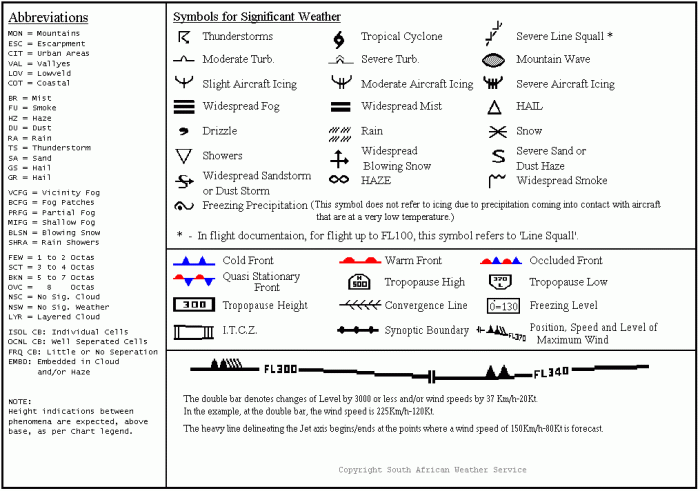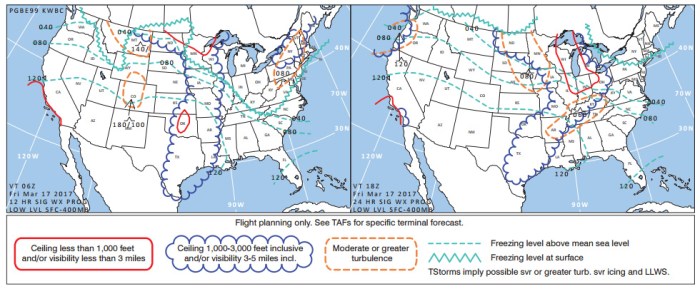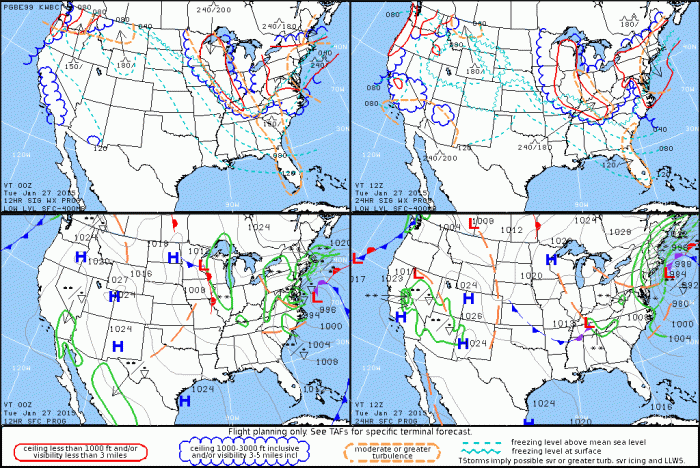Delving into the realm of high level significant weather prognostic chart legends, we embark on a journey to decipher the intricate symbols and notations that guide our understanding of weather patterns. These legends serve as indispensable tools for meteorologists and weather enthusiasts alike, enabling us to unravel the complex tapestry of atmospheric conditions that shape our world.
At the heart of every high level significant weather prognostic chart legend lies a comprehensive collection of symbols, colors, and line styles, each meticulously designed to convey specific weather phenomena. From swirling cyclones to gentle breezes, every element is carefully crafted to provide a visual representation of the atmospheric conditions being depicted.
High-Level Significant Weather Prognostic Chart Legend

A high-level significant weather prognostic chart legend is a critical tool for understanding and interpreting weather forecasts. It provides a visual representation of the symbols, colors, and line styles used on the chart, allowing users to quickly identify and track weather patterns.
Essential elements typically included in a legend include:
- Symbols representing different weather phenomena, such as fronts, precipitation, and clouds
- Colors indicating the intensity or severity of weather conditions
- Line styles denoting the movement or direction of weather systems
For example, a blue line with triangles pointing eastward may represent a cold front moving in that direction.
Interpretation and Application of the Legend, High level significant weather prognostic chart legend
To interpret the legend, users must first understand the meaning of each symbol, color, and line style. This information is typically provided in a key or explanation at the bottom of the chart.
Once the legend is understood, it can be used to identify and track weather patterns. For instance, a user can locate a cold front on the chart and follow its movement over time to predict when it will reach a particular location.
Customization and Regional Variations
High-level significant weather prognostic chart legends are often customized to specific regions and weather patterns. This is because the types of weather phenomena and their frequency can vary significantly from one area to another.
For example, a legend for a coastal region may include symbols for hurricanes and tropical storms, while a legend for a mountainous region may include symbols for avalanches and snowstorms.
Advancements in Legend Design
Recent advancements in legend design have focused on enhancing clarity and accuracy. Digital and interactive legends allow users to zoom in and out, rotate the chart, and change the colors and symbols to better visualize the weather data.
Automation has also played a significant role in legend creation, ensuring consistency and reducing the risk of human error.
Best Practices for Using the Legend
To effectively use a high-level significant weather prognostic chart legend, users should:
- Understand the limitations of the legend and supplement it with other sources of weather information
- Be aware of regional variations in legend design and content
- Use the legend responsibly and avoid spreading misinformation
User Queries: High Level Significant Weather Prognostic Chart Legend
What is the purpose of a high level significant weather prognostic chart legend?
A high level significant weather prognostic chart legend provides a standardized set of symbols, colors, and line styles used to represent weather phenomena on a chart, allowing for easy interpretation and understanding of weather forecasts.
How do I interpret the symbols in a high level significant weather prognostic chart legend?
Each symbol in the legend corresponds to a specific weather phenomenon, such as a cold front, warm front, or area of precipitation. By matching the symbols on the chart to the legend, you can determine the type of weather being forecasted.
Why is it important to customize the legend to specific regions?
Customizing the legend to specific regions allows for the inclusion of weather phenomena that are common to that area, ensuring that the chart is tailored to the local weather patterns.

